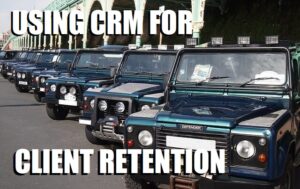For anyone in sales and marketing, and especially for business founders, client retention is always a focus, so here are 4 facts that should change your CRM system forever.
- Acquiring a new customer can cost five times more than retaining an existing customer
- Increasing customer retention by 5% can increase profits from 25-95%
- The success rate of selling to a customer you already have is 60-70%
- The success rate of selling to a new customer is 5-20%
With such compelling numbers it’s hardly surprising that companies are focussing like never before on retaining customers. On the whole, it appears to be working. In 2017, American Express found:
“Eight in 10 Americans (81%) report that businesses are meeting or exceeding their expectations for service, compared to 67 percent in 2014. In fact, 40 percent of consumers say businesses have increased their focus and attention on service, a significant increase in just three years (up from 29% in 2014).”
However, it is an ongoing challenge – the same report also highlighted:
“More than half of Americans have scrapped a planned purchase or transaction because of bad service, and 33 percent say they’ll consider switching companies after just a single instance of poor service.”
So how can your CRM system be configured to help with client retention?
Deliver what the customer wants, when they want it
Sound simple? In your CRM system, how many of the processes are about delivering for the customer, and how many are about your internal processes? Does the sale process map onto the buying process, or does it describe the route your sales people have to take through your internal systems and procedures? Can existing clients easily access your support and customer service team?
I am increasingly frustrated by companies who will not let me buy their product or service without a client ID number. If you rely on your internal Client ID’s to allow me to interact with your business, then don’t be surprised if I give up and go elsewhere. Try making your initial identification check something the client already knows. Easy to configure in CRM and virtually cost free, but delivers an instant improvement in customer perception. Suddenly I am no longer a number, I am customer that feels valued.
Make it easy for customers to like you.
Well configured CRM systems make “doing the expected unexpectedly well” easy. If your CRM is configured to allow easy interaction between you and your clients, then the next step is to help your users deliver the little extras that make your customer smile.
Increasingly, good customer service is the minimum standard that gets you considered. Now, more than ever, it is important to create experiences that go beyond what is expected and provide customers with “moments of delight.” If you are reading this on a wet Wednesday afternoon and thinking that all sounds a bit fluffy – bear with me.
CRM systems can quickly be configured to support loyalty schemes, indeed many are. So much so that some of us no longer see a loyalty bonus as a perk of dealing with a particular supplier. (In some cases the administration overhead makes it a disincentive to dealing with particular suppliers.) In part that feeling stems from the fact that the loyalty scheme has moved from being a differentiator to being part of the expected service level.
In 2017, I suggested that one trend to watch was the integration of CRM systems with mapping technology to product optimised territory planning for field based personnel. I still maintain that well thought through “drop-ins” that deliver real value to your clients is a fantastic differentiator and make it easier for the customer to know, and like, your business.
Listen and learn, then do something with that knowledge!
With such a focus on client retention, it’s sad that some have confused collecting customer feedback and Voice of the Customer (VoC) data with client retention. Modern CRM and Marketing Automation systems seem to spew increasing numbers of post purchase surveys. Every transaction now seems to require me to complete extra tasks to comply with the suppliers VoC program. I know that my positive comments and feedback are used by your marketing people to try and influence others. What I don’t know is what happens with negative comments?
If your business does not allow your sales people to gather feedback from clients directly and you have to use post-purchase surveys, make sure that you act on the feedback. Configure your surveys to provide escalation and feedback to the customer, not just statistics to your management.
Too often, CRM focuses on tools to help with the acquisition of new clients and the administration of internal sales processes. A few simple changes can have a disproportionate impact on your bottom line. Simply by building a focus on client retention you can make a big difference. After all, really happy customers talk, and word of mouth advertising is not only free, but possibly one of the most credible forms of advertising.





